![]()
![]()
Versions Of The Qur'an?
Islamic Awareness
© Islamic Awareness, All Rights Reserved.
Last Updated: 15th January 2002
Assalamu-alaikum wa rahamatullahi wa barakatuhu:
Jochen Katz wrote:
> } 1) How many 'versions' of the holy Quran is there today?
>
> At least two, probably more (I am pretty sure about the third
> one, but can't prove it yet, so I am not going to say where and
> what just yet), but it is common knowledge that the Hafs text
> and the Warsh text (mainly used in Northwest Africa) are
> different not only in the vowels but also in some consonants.
> The differences are small, but they are there. And both of them
> are for sale and in use today. Hafs is the much more common one.
> The third version I have heard about has by far more substantial
> differences in comparison to the other two. For the Warsh and
> Hafs differences see a few examples at:
>
> http://answering-Islam.org/Quran/Text/warsh.html
It has become a standard method of deception by Christian missionaries like Jochen Katz to superficially project issues that have been exhaustively addressed by both Muslims and Orientialsts, as we will see soon, inshallah. These missionaries are well aware of the difference between a transmission and a text (to be discussed in detail below). Yet, they intentionally replace one with the other in order to give the false impression to lay readers that the Qur'an exists in different texts. Thus, in order to address the questions of Hafs and Warsh, we will first offer a short introduction to the key concepts involved herein and then proceed to the heart of the matter, inshallah. However, before we begin this article, we would like to sincerely thank brother Moustafa Mounir Elqabbany from Canada and brother Muhammad Ghoniem from France, for providing valuable references. May Allah reward them profusely for their kind help. The contents of this document are divided as follows:
Revelation Of The Qur'an In Seven Ahrûf
It is a well-known fact that there are seven different ahrûf in which the Qur'an was revealed. In the Islamic tradition, this basis can be traced back to a number of hadîths concerning the revelation of the Qur'an in seven ahrûf (singular harf). Some of the examples of these hadîths are as follows:
From Abû Hurairah:
The Messenger of God(P) said: "The Qur'an was sent down in seven ahruf. Disputation concerning the Qur'an is unbelief" - he said this three times - "and you should put into practice what you know of it, and leave what you do not know of it to someone who does."[1]
From Abû Hurairah:
The Messenger of God(P) said: "An All-knowing, Wise, Forgiving, Merciful sent down the Qur'an in seven ahruf."[2]
From cAbdullâh Ibn Mascud:
The Messenger of God(P) said: "The Qur'an was sent down in seven ahruf. Each of these ahruf has an outward aspect (zahr) and an inward aspect (batn); each of the ahruf has a border, and each border has a lookout."[3]
The meaning of this hadîth is explained as:
As for the Prophet's(P) words concerning the Qur'an, each of the ahruf has a border, it means that each of the seven aspects has a border which God has marked off and which no one may overstep. And as for his words Each of the ahruf has an outward aspect (zahr) and an inward aspect (batn), its outward aspect is the ostensive meaning of the recitation, and its inward aspect is its interpretation, which is concealed. And by his words each border ...... has a lookout he means that for each of the borders which God marked off in the Qur'an - of the lawful and unlawful, and its other legal injunctions - there is a measure of God's reward and punishment which surveys it in the Hereafter, and inspects it ...... at the Resurrection ......[4]
And in another hadîth cAbdullâh Ibn Mascud said:
The Messenger of God(P) said: "The first Book came down from one gate according to one harf, but the Qur'an came down from seven gates according to seven ahruf: prohibiting and commanding, lawful and unlawful, clear and ambiguous, and parables. So, allow what it makes lawful, proscribe what it makes unlawful, do what it commands you to do, forbid what it prohibits, be warned by its parables, act on its clear passages, trust in its ambiguous passages." And they said: "We believe in it; it is all from our Lord."[5]
And Abû Qilaba narrated:
It has reached me that the Prophet(P) said: "The Qur'an was sent down according to seven ahruf: command and prohibition, encouragement of good and discouragement of evil, dialectic, narrative, and parable."[6]
These above hadîths serve as evidence that the Qur'an was revealed in seven ahruf. The defination of the term ahruf has been the subject of much scholarly discussion and is included in the general works of the Qur'an. The forms matched the dialects of following seven tribes: Quraysh, Hudhayl, Thaqîf, Hawâzin, Kinânah, Tamîm and Yemen. The revelation of the Qur'an in seven different ahruf made its recitation and memorization much easier for the various tribes. At the same time the Qur'an challenged them to produce a surah like it in their own dialect so that they would not complain about the incomprehensibility.
For example, the phrase 'alayhim (on them) was read by some 'alayhumoo and the word siraat (path, bridge) was read as ziraat and mu'min (believer) as moomin.[7]
Difference Between Ahrûf & Qirâ'ât
It is important to realize the difference between ahruf and Qirâ'ât. Before going into that it is interesting to know why the seven ahruf were brought down to one during cUthmân's(R) time.
The Qur'an continued to be read according to the seven ahruf until midway through Caliph 'Uthman's rule when some confusion arose in the outlying provinces concerning the Qur'an's recitation. Some Arab tribes had began to boast about the superiority of their ahruf and a rivalry began to develop. At the same time, some new Muslims also began mixing the various forms of recitation out of ignorance. Caliph 'Uthman decided to make official copies of the Qur'an according to the dialect of the Quraysh and send them along with the Qur'anic reciters to the major centres of Islam. This decision was approved by Sahaabah and all unofficial copies of the Qur'an were destroyed. Following the distribution of the official copies, all the other ahruf were dropped and the Qur'an began to be read in only one harf. Thus, the Qur'an which is available through out the world today is written and recited only according to the harf of Quraysh.[8]
Now a few words on Qirâ'ât:
A Qirâ'ât is for the most part a method of pronunciation used in the recitations of the Qur'an. These methods are different from the seven forms or modes (ahruf) in which the Qur'an was revealed. The seven modes were reduced to one, that of the Quraysh, during the era of Caliph 'Uthman, and all of the methods of recitation are based on this mode. The various methods have all been traced back to the Prophet(P) through a number of Sahaabah who were most noted for their Qur'anic recitations. That is, these Sahaabah recited the Qur'an to the Prophet(P) or in his presence and received his approval. Among them were the following: Ubayy Ibn K'ab, 'Alee Ibn Abi Taalib, Zayd Ibn Thaabit, 'Abdullah Ibn Mas'ud, Abu ad-Dardaa and Abu Musaa al-Ash'aree. Many of the other Sahaabah learned from these masters. For example, Ibn 'Abbaas, the master commentator of the Qur'an among the Sahaabah, learned from both Ubayy and Zayd.[9]
The transmission of the Qur'an is a mutawâtir transmission, that is, there are a large number of narrators on each level of the chain. Dr. Bilaal Philips gives a brief account of the history of recitation in his book:
Among the next generation of Muslims referred to as Taabe'oon, there arose many scholars who learned the various methods of recitation from the Sahaabah and taught them to others. Centres of Qur'anic recitation developed in al-Madeenah, Makkah, Kufa, Basrah and Syria, leading to the evolution of Qur'anic recitation into an independent science. By mid-eighth century CE, there existed a large number of outstanding scholars all of whom were considered specialists in the field of recitation. Most of their methods of recitations were authenticated by chains of reliable narrators ending with the Prophet(P). Those methods which were supported by a large number of reliable narrators on each level of their chain were called Mutawaatir and were considered to be the most accurate. Those methods in which the number of narrators were few or only one on any level of the chain were refered to as shaadhdh. Some of the scholars of the following period began the practice of designating a set number of individual scholars from the pervious period as being the most noteworthy and accurate. By the middle of the tenth century, the number seven became popular since it coincided with the number of dialects in which the Qur'an was revealed.[10]
The author went on to say:
The first to limit the number of authentic reciters to seven was the Iraqi scholar, Abu Bakr Ibn Mujâhid (d. 936CE), and those who wrote the books on Qirâ'ah after him followed suit. This limitation is not an accurate reprensentation of the classical scholars of Qur'anic recitation. There were many others who were as good as the seven and the number who were greater than them.[11]
Concerning the seven sets of readings, Montgomery Watt and Richard Bell observe:
The seven sets of readings accepted by Ibn-Mujâhid represent the systems prevailing in different districts. There was one each from Medina, Mecca, Damascus and Basra, and three from Kufa. For each set of readings (Qirâ'a), there were two slightly different version (sing. Riwaya). The whole may be set out in tabular form:[12]
|
District |
Reader |
First Rawi |
Second Rawi |
|
Medina |
Nafîc |
Warsh |
Qâlûn |
|
Mecca |
Ibn Kathîr |
al-Bazzî |
Qunbul |
|
Damascus |
Ibn Amir |
Hisham |
Ibn Dhakwân |
|
Basra |
Abu cAmr |
ad-Dûrî |
al-Sûsî |
|
Kûfa |
cAsim |
Hafs |
Shcuba |
|
Kûfa |
Hamza |
Khalaf |
Khallad |
|
Kûfa |
al-Kisâ'i |
ad-Dûrî |
Abul-Harîth |
Other schools of Qirâ'ât are of:
Conditions For The Validity Of Different Qirâ'ât
Conditions were formulated by the scholars of the Qur'anic recitation to facilitate critical analysis of the above mentioned recitations. For any given recitation to be accepted as authentic (Sahih), it had to fulfill three conditions and if any of the conditions were missing such a recitation was classified as Shâdhdh (unusual).
The Chain Of Narration Of Different Qirâ'ât
In this section, the chain of narration or isnad of each Qirâ'ât will be presented. It is worth noting that the chains of narration here are mutawâtir.
Qirâ'a from Madinah: The reading of Madinah known as the reading of Nâfic Ibn Abî Nacîm (more precisely Abû cAbd ar-Rahmân Nâfic Ibn cAbd ar-Rahmân).
Nâfic died in the year 169 H. He reported from Yazîd Ibn al-Qacqâc and cAbd ar-Rahmân Ibn Hurmuz al-'Araj and Muslim Ibn Jundub al-Hudhalî and Yazîd Ibn Român and Shaybah Ibn Nisâ'. All of them reported from Abû Hurayrah and Ibn cAbbâs and cAbdallâh Ibn 'Ayyâsh Ibn Abî Rabî'ah al-Makhzûmî and the last three reported from Ubayy Ibn Kacb from the Prophet(P).[14]
From Nâfic, two major readings came to us : Warsh and Qâlûn.
Qirâ'a from Makkah: The reading of Ibn Kathîr (cAbdullâh Ibn Kathîr ad-Dârî):
Ibn Kathîr died in the year 120 H. He reported from cAbdillâh Ibn Assa'ib al-Makhzûmî who reported from Ubayy Ibn Kacb (The companion of the Prophet(P)).
Ibn Kathîr has also reported from Mujâhid Ibn Jabr who reported from his teacher Ibn cAbbâs who reported from Ubayy Ibn Kacb and Zayd Ibn Thâbit and both reported from the Prophet(P).[15]
Qirâ'a from Damascus: From ash-Shâm (Damascus), the reading is called after cAbdullâh Ibn cAamir.
He died in 118 H. He reported from Abû ad-Dardâ' and al-Mughîrah Ibn Abî Shihâb al-Makhzûmî from cUthmân.[16]
Qirâ'a from Basrah: The reading of Abû cAmr from Basrah:
(According to al-Sabcah, the book of Ibn Mujâhid page 79, Abû cAmr is called Zayyan Abû cAmr Ibn al-cAlâ'. He was born in Makkah in the year 68 and grew up at Kûfah.) He died at 154 H. He reported from Mujâhid and Sacîd Ibn Jubayr and 'Ikrimah Ibn Khâlid al-Makhzûmî and 'Atâ' Ibn Abî Rabâh and Muhammad Ibn cAbd ar-Rahmân Ibn al-Muhaysin and Humayd Ibn Qays al-cA'raj and all are from Makkah.
He also reported from Yazîd Ibn al-Qacqâc and Yazîd Ibn Rumân and Shaybah Ibn Nisâ' and all are from Madinah.
He also reported from al-'Assan and Yahyâ Ibn Yacmur and others from Basrah.
All these people took from the companions of the Prophet(P).[17]
From him came two readings called as-Sûsi and ad-Dûrî.
Qirâ'a from Basrah: From Basrah, the reading known as
Yacqûb Ibn Ishâq al-Hadramî the companion of Shucbah (again). He reported from Abû cAmr and others.[18]
Qirâ'a from Kûfah:The reading of cAasim Ibn Abî an-Najûd (cAasim Ibn Bahdalah Ibn Abî an-Najûd):
He died in the year 127 or 128 H. He reported from Abû cAbd ar-Rahmân as-Solammî and Zirr Ibn Hubaysh.
Abû cAbd ar-Rahmân reported from cUthmân and cAlî Ibn Abî Tâlib and 'Ubayy (Ibn Kacb) and Zayd (Ibn Thâbit).
And Zirr reported from Ibn Mascud.[19]
Two readings were repoted from cAasim: The famous one is Hafs, the other one is Shucbah.
Qirâ'a from Kûfah: The reading of Hamzah Ibn Habîb (from Kûfah as well)
Hamzah was born in the year 80 H and died in the year 156 H. He reported from Muhammad Ibn cAbd ar-Rahmân Ibn Abî Laylâ (who reads the reading of cAlî Ibn Abî Tâlib (RA), according to the book of Ibn Mujâhid called al-Sabcah - The Seven - page 74) and Humrân Ibn A'yan and Abî Ishâq as-Sabî'y and Mansur Ibn al-Mu'tamir and al-Mughîrah Ibn Miqsam and Jacfar Ibn Muhammad Ibn cAlî Ibn Abî Tâlib from the Prophet(P).[20]
Qirâ'a from Kûfah: The reading of al-'Amash from Kûfah as well:
He reported from Yahyâ Ibn Waththâb from 'Alqamah and al-'Aswad and 'Ubayd Ibn Nadlah al-Khuzâ'y and Abû cAbd ar-Rahmân as-Sulamî and Zirr ibn Hubaysh and all reported from Ibn Mascud.[21]
Qirâ'a from Kûfah: The reading of cAli Ibn Hamzah al-Kisâ'i known as al-Kisâ'i from Kûfah.
He died in the year 189 H. He reported from Hamzah (the previous one) and cIesâ Ibn cUmar and Muhammad Ibn cAbd ar-Rahmân Ibn Abî Laylâ and others.[22]
Now our discussion will be on Hafs and Warsh Qirâ'ât.
Hafs & Warsh Qirâ'ât: Are They Different Versions Of The Qur'an?
The Christian missionary Jochen Katz had claimed that Hafs and Warsh Qirâ'ât are different 'versions' of the Qur'an. A concise and interesting article that the missionary had used to reach such a conclusion can be found in the book Approaches of The History of Interpretation of The Qur'an. Ironically, it contained an article by Adrian Brockett, titled "The Value of Hafs And Warsh Transmissions For The Textual History Of The Qur'an", which sheds some light on various aspects of differences between the two recitations. It is also worth noting that, in contrast to Mr. Katz, Brockett used the word transmission rather than text for these two modes of recitations. Some highlights from the article are reproduced below.
Brockett states:
In cases where there are no variations within each transmission itself, certain differences between the two transmissions, at least in the copies consulted, occur consistently throughout. None of them has any effect in the meaning.[23]
The author demarcates the transmissions of Hafs and Warsh into differences of vocal form and the differences of graphic form. According Brockett:
Such a division is clearly made from a written standpoint, and on its own is unbalanced. It would be a mistake to infer from it, for instance, that because "hamza" was at first mostly outside the graphic form, it was therefore at first also outside oral form. The division is therefore mainly just for ease of classification and reference.[24]
Regarding the graphic form of this transmission, he further states:
On the graphic side, the correspondences between the two transmissions are overwhelmingly more numerous than differences, often even with oddities like ayna ma and aynama being consistently preserved in both transmissions, and la'nat allahi spelt both with ta tawila and ta marbuta in the same places in both transmissions as well, not one of the graphic differences caused the Muslims any doubts about the faultlessly faithful transmission of the Qur'an.[25]
And on the vocal side of the transmission the author's opinion is:
On the vocal side, correspondences between the two transmissions again far and away outnumber the differences between them, even with the fine points such as long vowels before hamzat at-qat having a madda. Also, not one of the differences substantially affects the meaning beyond its own context... All this point to a remarkably unitary transmission in both its graphic form and its oral form.[26]
He also discusses the Muslims' and orientalists' attitude towards the graphic transmission:
Many orientalists who see the Qur'an as only a written document might think that in the graphic differences can be found significant clues about the early history of the Qur'an text - if cUthmân issued a definitive written text, how can such graphic differences be explained, they might ask. For Muslims, who see the Qur'an as an oral as well as a written text, however, these differences are simply readings, certainly important, but no more so than readings involving, for instances, fine differences in assimilation or in vigour of pronouncing the hamza.[27]
Brockett goes so far as to provide examples with which the interested reader can carry out an extended analysis. Thus, he states:
The definitive limit of permissible graphic variation was, firstly, consonantal disturbance that was not too major, then unalterability in meaning, and finally reliable authority.
In the section titled, "The Extent To Which The Differences Affect The Sense", the author repeats the same point:
The simple fact is that none of the differences, whether vocal or graphic, between the transmission of Hafs and the transmission of Warsh has any great effect on the meaning. Many are the differences which do not change the meaning at all, and the rest are differences with an effect on the meaning in the immediate context of the text itself, but without any significant wider influence on Muslim thought.[28]
The above is supported by the following:
Such then is the limit of the variation between these two transmissions of the Qur'an, a limit well within the boundaries of substantial exegetical effect. This means that the readings found in these transmissions are most likely not of exegetical origin, or at least did not arise out of crucial exegetigal dispute. They are therefore of the utmost value for the textual history of the Qur'an.[29]
And interestingly enough the author went on to say:
The limits of their variation clearly establish that they are a single text.[30]
Furthermore, we read:
Thus, if the Qur'an had been transmitted only orally for the first century, sizeable variations between texts such as are seen in the hadîth and pre-Islamic poetry would be found, and if it had been transmitted only in writing, sizeable variations such as in the different transmissions of the original document of the constitution of Medina would be found. But neither is the case with the Qur'an. There must have been a parallel written transmission limiting variation in the oral transmission to the graphic form, side by side with a parallel oral transmission preserving the written transmission from corruption.[31]
The investigation led to another conviction:
The transmission of the Qur'an after the death of Muhammad was essentially static, rather than organic. There was a single text, and nothing significant, not even allegedly abrogated material, could be taken out nor could anything be put in.[32]
Finally, we would like to establish Adrian Brockett's conclusion on this matter:
There can be no denying that some of the formal characteristics of the Qur'an point to the oral side and others to the written side, but neither was as a whole, primary. There is therefore no need to make different categories for vocal and graphic differences between transmissions. Muslims have not. The letter is not a dead skeleton to be refleshed, but is a manifestation of the spirit alive from beginning. The transmission of the Qur'an has always been oral, just as it has been written.[33]
Therefore, it comes as no surprise that Christian missionaries like Jochen Katz find themselves "refleshing" a dead skeleton in order to comply with their missionary program of outright deception. Of course, regular participants in the newsgroups have time and again witnessed Jochen's tiring displays of dialectical acrobatics - the misquoting of references and the juggling of facts. Surprisingly enough, missionary Katz cannot even support his point of view using the reference [23], which undermines his missionary agenda of twisting the facts. The reference [23] has firmly established that:
Recitation Of The Qur'an in Hafs, Warsh & Other Qirâ'ât
A few centuries ago, the Qurra, or reciters of the Qur'an, used to take pride in reciting all seven Qirâ'ât. In light of this fact, we decided to make an informal inquiry into some the Qurra who recite in different Qirâ'ât. Two brothers confirmed the following:
Date: 18 Sep 1997 13:44:37 -0700
From: Moustafa Mounir Elqabbany
Newsgroups: soc.religion.islamI can confirm that al-Husarî did in fact record the entire Qur'an in Warsh, as I have the recording in my possession. A Somali brother also indicated to me that he has a copy of the Qur'an recited in Al-Doori ('an Abî cAmr) recited, again, by al-Husarî. The Qur'an is very widely read and recorded in Qawloon in Libya and Tunisia, so it shouldn't be difficult to acquire those Qirâ'ât either.
And another brother corroborated the following in a private e-mail:
Date: Mon, 27 Oct 1997 21:59:24 +0100
From: Mohamed Ghoniem
To: Metallica
Subject: Re: readingsWell, before al-Husary, Abdel Bassit Abdus Samad has recorded the entire Qur'an in Warsh and many cassettes and CDs are on sale everywhere in the Egypt and in France as well. I personally have in Cairo many recordings of other readers such as Sayyed Mutawally and Sayyed Sa'eed exclusively in Warsh. I have seen several cassettes in the reading of Hamzah (from Khalaf's way) on sale in Egypt and I have bought a couple of them during this summer. They were recorded by Sheikh 'Antar Mosallam.
Presently, I have got two CDs recorded by Sheikh Abdel Bassit gathering three readings (Hafs, Warsh and Hamzah). These CDs belong to a series of six CDs on sale publicly in France in the fnac stores.
Printed Edition Of The Qur'an In Various Qirâ'ât
The different Qirâ'ât exist in the printed editions. This would be news for most missionaries, aside from the ones who bitterly conceal these facts. Most of the masâhif of the Qur'an carry either in the beginning or in the end the rules of pronunciation of that Qirâ'a as well as the isnad. This is to enable the readers to properly read the Qur'an.
A few examples of the printed edition of masâhif of the Qur'an in various Qirâ'ât are given below:
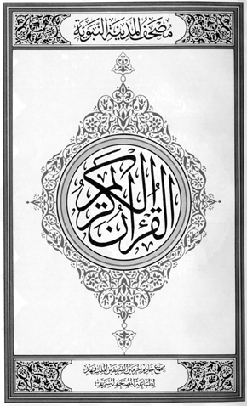
This is a well known and common mushâf of the Qur'an printed in the Saudi Arabia. They have adopted the Hafs Qirâ'a. Hafs is the most common type of Qirâ'a used in the Muslim world.
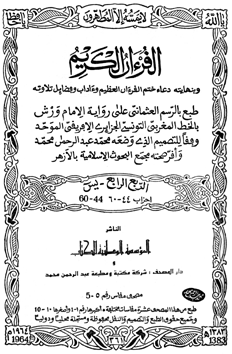
This is a mushâf from Algeria with the riwaya of Warsh. It is important to note that all the masahif are written in rasm al-'Uthmani. Also notice the Qaf written with one dot on top in Maghribi script!
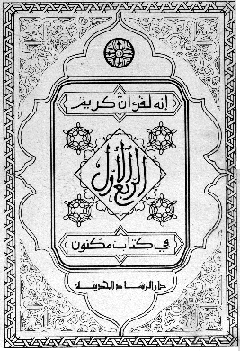
Yet another mushâf in the riwaya of Warsh. This is printed in Morocco.
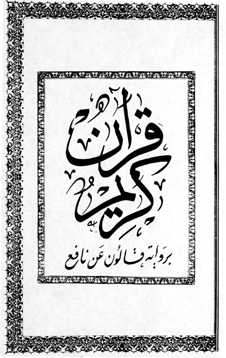
The riwaya Qâlûn from Nâfîc. This mushâf is published in Tunisia by ad-Dâr at-Tunissia lilnashr.
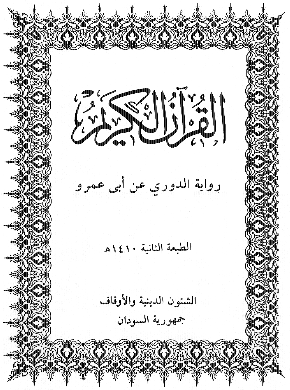
The Qur'an in the riwaya of ad-Dûrî from Abî cAmrû. This mushâf is from Sudan.
We have already shown above some of the printed edition of the masâhif of the Qur'an in different Qirâ'ât.
Below are the examples of the books which deals with ten mutawâtir readings.
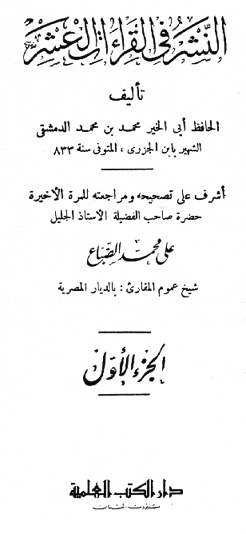
This book al-Nashr fi-l-Qirâ'ât al-cAshr by Ibn al-Jazrî who died in 833 AH. This is a standard book used by students of the science of Qirâ'ât. This is the edition from Dâr al-Kutub cIlmiyyah, Beirut, Lebanon. Not surprisingly, this book is also used by Adrian Brockett, in his article "The Value of Hafs And Warsh Transmissions For The Textual History Of The Qur'an".[34]
The below one a very recent book.
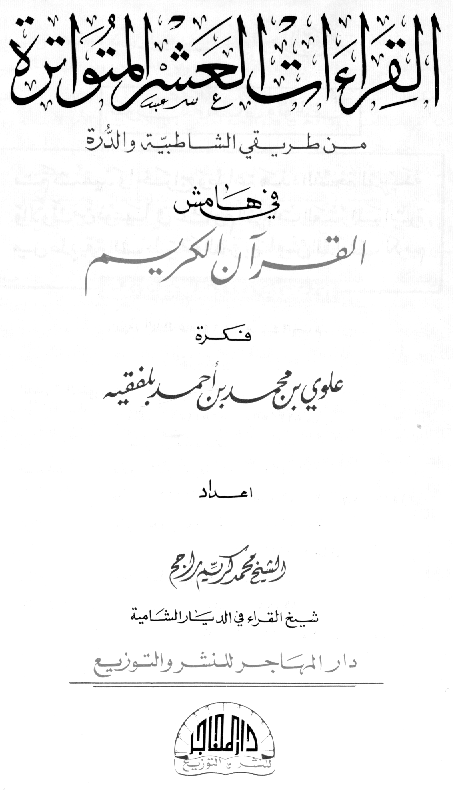
For the benefit of the English speaking readers, we translate the Arabic in the above text.
The Ten Mutawâtir
Readings
from the ways of ash-Shatbiyyah
and ad-Durrah
In the Margin of
The Holy Qur'an
an idea from
cAlawi Ibn Muhammad Ibn Ahmad Bilfaqih
carried out by
Shaykh Muhammad Karîm Râjih
The Chief Reader in the
Syrian land
Dâr al-Muhâjir for Publications & Distribution
This book is a third print published in 1414AH/1994 CE. This book claims as a
...unique and first work of this kind in the field of Science of the ten Mutawâtir readings from the ways of ash-Shatbiyyah and ad-Durrah in the margin of the Holy Qur'an is now achieved, edited, and printed.[35]
The 10 readers/transmitters of the mutawâtir readings are listed here. What is more interesting is that there are reciters even to this day who have memorised the Qur'an in all the 10 mutawâtir readings.
In the end, I address Shaykh Kurayyim Râjih the Head of the Readers in the Syrian lands with my gratitude for carrying out that work and supervising its course and supplementing it with valuable guidelines that hardly come from anyone except an expert like him.
May God reward his kind student and reader Muhammad Fahd Khârûf who masters the ten Mutawâtir readings from the ways of ash-Shatbiyyah and ad-Durrah and at-Tibah for participating to this noble task making it, with the divine help, a beneficial work for the holders of God's Almighty Book and his readers.[36]
Conclusions
In light of the above discussion, it is clear that Hafs and Warsh Qirâ'ât are not the different 'versions' or 'texts' of the Qur'an as fantasized by missionary Katz. The mutawâtir follows directly to the Companions of the Prophet(P) who took the Qur'an from the Prophet(P) himself. Thus, the suggestion that a mutawâtir reading was a later invention by the Muslims is to be dismissed as complete fiction.
Related Articles
| Islamic Awareness |
References
[1] Abû Jacfar Muhammad bin Jarîr al-Tabarî (Translated & Abridged by J Cooper, W F Madelung and A Jones), Jamic al-Bayân 'an Tâ'wil ay al-Qur'an, 1987, Volume 1, Oxford University Press & Hakim Investment Holdings (M.E.) Limited, p. 16.
[2] Ibid.
[3] Ibid.
[4] Ibid., p. 31.
[5] Ibid., p. 29.
[6] Ibid.
[7] Abu Ameenah Bilal Philips, Tafseer Soorah Al-Hujuraat, 1990, Tawheed Publications, Riyadh, p. 27.
[8] Ibid., pp. 28-29.
[9] Ibid., pp. 29-30.
[10] Ibid., p. 30.
[11] Ibid.
[12] W M Watt & R Bell, Introduction To The Qur'an, 1994, Edinburgh at University Press, p. 49.
[13] Abu Ameenah Bilal Philips, Tafseer Soorah Al-Hujuraat, Op. Cit., p. 32.
[14] Abû Muhammad cAlî Ibn Ahmad Ibn Sacîd Ibn Hazm al-Andalûsî (384-456 H), Ar-Rasâ'il al-Khamsah (A Booklet In Magazine Al-Azhar), 1993, p. 7.
[15] Ibid.
[16] Ibid., pp. 9-10.
[17] Ibid., p. 9.
[18] Ibid.
[19] Ibid., pp. 7-8.
[20] Ibid., p. 8.
[21] Ibid.
[22] Ibid., pp. 8-9."
[23] Adrian Brockett, "The Value of Hafs And Warsh Transmissions For The Textual History Of The Qur'an" in Andrew Rippin's (Ed.), Approaches of The History of Interpretation of The Qur'an, 1988, Clarendon Press, Oxford, p. 33.
[24] Ibid., pp. 33-34.
[25] Ibid., p. 34.
[26] Ibid.
[27] Ibid., p. 35.
[28] Ibid., p. 37.
[29] Ibid., p. 43.
[30] Ibid.
[31] Ibid., p. 44.
[32] Ibid.
[33] Ibid., p. 45.
[34] Ibid., p. 35, see footnote 14.
[35] cAlawi Ibn Muhammad Ibn Ahmad Bilfaqih, Al-Qirâ'ât al-cAshr al-Mutawâtir, 1994, Dâr al-Muhâjir, See the back of the cover page.
[36] ibid.